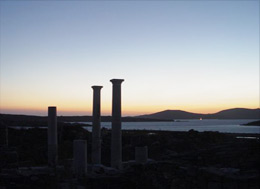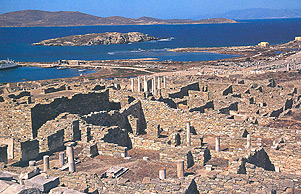Delos

King of Delos
What makes Delos one of the most outstanding archeological sites in Greece is the fact that it is an entire ancient city, complete with its own port, temples, and sanctuaries, market places, theater, gymnasium, stadium, and many private residences, which remain in a well-preserved condition. The birthplace of Apollo, a very important place of worship, a cosmopolitan town, and a busy port, Delos was all of these rolled together.
Discover Delos: As one leaves the modern, cosmopolitan Mykonos behind, heading for Delos for the first time, one cannot but wonder why the ancient Greeks chose this small rocky island (5 sq. km.) as the birthplace of God Appollo and as his most important sanctuary, rather that any one of the bigger, more fertile neighboring island. What is certain is that in ancient Greece nothing occurred truly by chance, thus the location , founding and functioning of shires, temples and oracles complied with specific criteria.
Moreover it is a well-known fact that the sunlight over Delos is of even greater brightness and penetrating clarity that that of any other sun-drenched islands of the Cyclades. Is it really any wonder then, that Delos was the most suitable choice as the birthplace of Apollo, the god of light and the sun god?

What to visit
- The Sanctuary of Apollo
- The Stadium Districts
- The Theatre Districts
- The area East and Southeast of the Sanctuary
- The Sanctuaries of Mount Kynthos
- The Lake and the Hill Districts
- The area of Inopus and the Sanctuaries of the Foreign Gods
- The Museum of Delos
History
Human habitation on the island of Delos dates back to at least the 3rd millennium BC. Its first inhabitants must have been Carians. This at least is argued by Thucydides who associated with them the iron weapons found in graved during the Cleasing of 426-425 BC. Myths about Anios, father of the Delians, and about Rhadanabthus of Crete, indicate that the Cretans must have had relations with the little island of Delos because of its special geographic location in the Aegean.
The Carian was succeeded by the Mycenaeans, and then by the Ionians, who came from the coast of Asia Minor, and whoa s early as c. 700 BC organized splendid festivals there. Visitors from all parts of Ionia would come and worship Apollo with dances, hymns and contests. Excavations on Delos started in 1873 by the French School of Archaeology at Athens. Between 1904 and 1914, under the direction of M. Holleaux and thanks to the donation of Duke de Loubat, the most significant sections of the ancient site were uncovered.

Delos Archaeological Museum
Delos Museum was built in 1904 by the Archaeological Society at Athens and originally consisted of the five western rooms. It was enlarged in 1931 and 1972 and in the same period, the exterior of the building underwent great, but unfortunate, alterations. The present exhibition is arranged in nine rooms. Six rooms contain the statues and relieves found in Delos (one of the best collections in the world), two rooms contain pottery ranging from the prehistoric to the late Hellenistic period, and the last one contains various objects of everyday life, found in the private houses. However, the exhibition is not yet complete.







